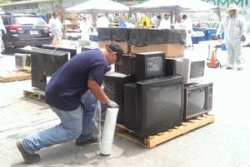


Car after car lined up during Saturday’s “Too Toxic to Trash” household hazardous and e-waste round up that was hosted in Culver City.
“The program started in 1988 through the county and Culver City has at least done it for 10 years,” Supervisor Engineering Technician for L.A. County Sanitation Larry Myers said. “In Culver City it is just one event a year but every weekend, for the most part, there is a place in L.A. County where we are having an event and they rotate around once a year in every site.”
“Too Toxic to Trash” was organized through Culver City’s Department of Public Works, L.A. County Public Works, along with the L.A. County Sanitation District. The drop off location was set right in front of the Wende Museum in order to facilitate the flow of cars arriving, dropping of waste materials.
“We used to do it out at West L.A. College but we lost that location because it was under construction. So we relocated to this site which is city owned,” Environmental Coordinator for Culver City Catherine Vargas said. “It is the law that hazardous material can not be disposed of in a trash can. It is very important for people to understand that it is illegal to pour paint or chemicals into the sink or the way stream. There is a push to educate people and remind them.”
The county tracks all of the disposal material and all of the cars driving through the drop-off zone. Those numbers are then included in a report, which is sent to the state. The same report then goes to the city and which helps the city create its own report indicating to the state how much hazardous materials residents and businesses are generating. Culver City will also be required to declare how much hazardous waste is being collected and disposed of within its boundaries.
Myers predicted that the day’s round-up would generate approximately 600 loads and of those loads he expected 14,000 pounds of paint, with about 400 gallons of motor oil and 300 gallons of antifreeze. The rest of the waste would be made of other miscellaneous items.
“It is estimated that 80 percent of what is dropped off is recycled; electronics are 100 percent recycled, latex paint is recycled as are fluorescent tubes and it is all handled by the contractors,” Myers said. “That is the point: to keep it out of the landfills because it is not good for the ground water. It is not good for the landfills to be seeping over. It takes decades to happen but it still happens.”
For all parties involved, having such collection sites made available will not only remove hazardous materials in a safe and effective manner but it will help educate the general public about proper disposal of such items.
“The whole idea is to drive up, drop off and drive away; there is no hassle,” Vargas said. “The hardest part is gathering the material, boxing it up and putting it in one’s trunk. The people here will gather it for you since they don’t want people getting out of their car.”











